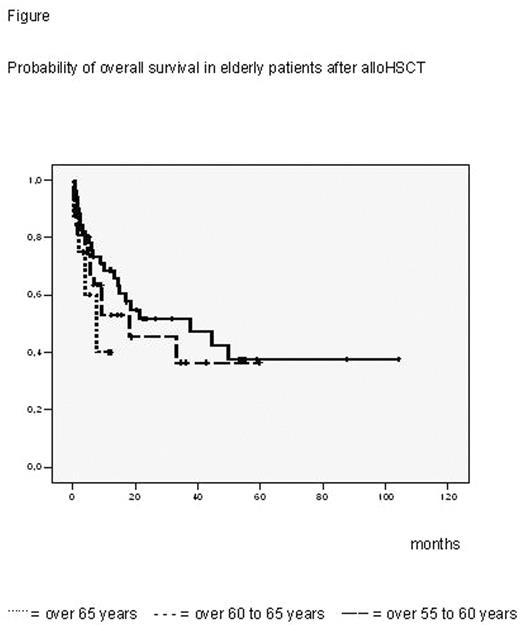Abstract
Allogeneic hematopoietic cell transplantation (alloHSCT) has curative potential in many hematologic malignancies; however, substantial treatment related toxicity has restricted its use to younger patients (mostly under 55 years of age). With the development of conditioning regimens of reduced intensity, alloHSCT is being applied more widely in elderly patients, too. Here we report the results of all consecutive alloHSCT recipients above the age of 55 years transplanted at our institution between October 1996 and April 2006. Among 89 elderly patients transplanted, 50 patients were in the age group over 55 to 60 years, 31 patients in the cohort over 60 to 65 years, and 8 patients were older than 65 years. 36 patients were female and 53 male. Diagnoses included acute lymphoblastic leukemia (ALL, 10 patients), acute myelogenous leukemia (AML, 32), myelodysplastic syndromes (MDS) or secondary AML (30), chronic myelogenous leukemia (CML, 5), agnogenic myeloid metaplasia (AMM, 3), lymphoma (5), and multiple myeloma (4 patients). Advanced disease was present in 63 patients (71%) at the time of transplant. 85 patients (96%) had a WHO performance score of 0 or 1. Conditioning regimen was myeloablative in 20 patients (22%) and of reduced intensity in 69 patients (78%); in 46 patients (52%) irradiation was part of the conditioning regimen. Stem cell source was peripheral blood in 83 patients (93%) and bone marrow in 6 (7%). 32 patients (36%) received a graft from a related donor and 57 (64%) from an unrelated donor. After a median follow-up of 9 months (range: 1 to 104), 24 patients have since relapsed (27%). Treament related mortality was 27% (24 of 89 patients). 34 patients developed acute graft-versus-host disease (GvHD, 38%) and chronic GvHD was diagnosed in 25 of 71 patients at risk (35%). As of August 1st, 2006, 47 of 89 patients were alive and 41 of 89 in complete remission. Probabilities of overall and disease-free survival at three years were 45 and 32%, respectively. Interestingly, overall and disease-free survival were similar among the three age cohorts. In conclusion, according to our experience, alloHSCT is feasible in elderly patients of appropriate performance status, with acceptable relapse rates and toxicity.
Figure Probability of overall survival in elderly patients after alloHSTC
Figure Probability of overall survival in elderly patients after alloHSTC
Disclosure: No relevant conflicts of interest to declare.
Author notes
Corresponding author


This feature is available to Subscribers Only
Sign In or Create an Account Close Modal